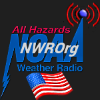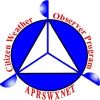About This Station
For the last 15 years, this station has been powered by a Honeywell TN924 Weather Information Station. Data is collected and uploaded to the website(s) approximately every 10-15 seconds. The data on this website is currently collected using Weather Display software running on a Windows 11 computer. Station hardware consists of a wireless (433Mhz) anemometer [offline at present], a wireless rain gauge, and a wireless temp-humidity sensor, all situated for highest possible accuracy given hardware radio range constraints. Station data generally conforms to MADIS Qality Control standards, as this station participates in the Citizen Weather Observer Program. (CWOP data is used by the NOAA for some forecasting purposes, so it is statistically quality-checked by an automated system. (Basically, the information quality from this station should be on a par with your local TV station, though there may be occasional issues with the less expensive hardware.) However, please remember to never base important decisions on this or any weather information obtained from the Internet
This website is checked for functionality using several different web browsers. Should you experience any difficulties, please hit the contact link at the bottom of the page and let me know. (Please do NOT send complaints about the actual weather conditions, as I don't control those...yet!)
About This City
(Source: http://en.wikipedia.org/wiki/Saint_Louis,_Missouri)St. Louis is the second-largest (by population) city in the U.S. state of Missouri. The city has an estimated population of 356,587 and is the principal municipality of Greater St. Louis, population 2,892,874, the largest urban area in Missouri and 15th-largest in the United States
Climate
(Source: http://en.wikipedia.org/wiki/Saint_Louis,_Missouri)St. Louis lies in the transitional zone between the humid continental climate type and the humid subtropical climate type (Koppen Dfa and Cfa, respecively), with neither large mountains nor large bodies of water to moderate its temperature. It is subject to both cold Arctic air and hot, humid tropical air from the Gulf of Mexico. The city has four distinct seasons. Spring is the wettest season and produces severe weather ranging from tornadoes to winter storms. Summers are hot and humid, and the humidity often makes the heat index rise to temperatures feeling well above 100F (38C). Fall is mild with lower humidity and can produce intermittent bouts of heavy rainfall with the first snow flurries usually forming in late November. Winters can be cold at times with periodic light snow and temperatures below freezing. Winter storm systems, such as Alberta Clippers and Panhandle hooks, can bring days of heavy freezing rain, ice pellets, and snowfall.
The average annual temperature for the years 1970-2000, recorded at nearby Lambert-Saint Louis International Airport, is 56.3F (13.5C), and average precipitation is 38.9 inches (990 mm). The normal high temperature in July is 90F (32C), and the normal low temperature in January is 21F (-6C), although this varies from year to year. Both 100F (37.8C) and 0F (-17.8C) temperatures can be seen on an average 2 or 3 days per year. The official record low is -22F (-30C) on January 5, 1884, and the record high is 115F (46C) on July 14, 1954.
Winter (December through February) is the driest season, with an average 7.3 inches (185 mm) of precipitation. The average seasonal snowfall of 22.2 inches (56 cm). Spring (March through May), is typically the wettest season, with 11.4 inches (290 mm) of precipitation. Dry spells lasting one to two weeks are common during the growing seasons.
St. Louis experiences thunderstorms 48 days a year on average. Especially in the spring, these storms can often be severe, with high winds, large hail and tornadoes. St. Louis has been affected on more than one occasion by particularly damaging tornadoes.
Some late autumns feature the warm weather known as Indian summer; some years see roses in bloom as late as early December.
About This Website
This site is a template design by CarterLake.org with PHP conversion by Saratoga-Weather.org.
Special thanks go to Kevin Reed at TNET Weather for his work on the original Carterlake templates, and his design for the common website PHP management.
Special thanks to Mike Challis of Long Beach WA for his wind-rose generator, Theme Switcher and CSS styling help with these templates.
Special thanks go to Ken True of Saratoga-Weather.org for the AJAX conditions display, dashboard and integration of the TNET Weather common PHP site design for this site.
Template is originally based on Designs by Haran.
This template is XHTML 1.0 compliant. Validate the XHTML and CSS of this page.



